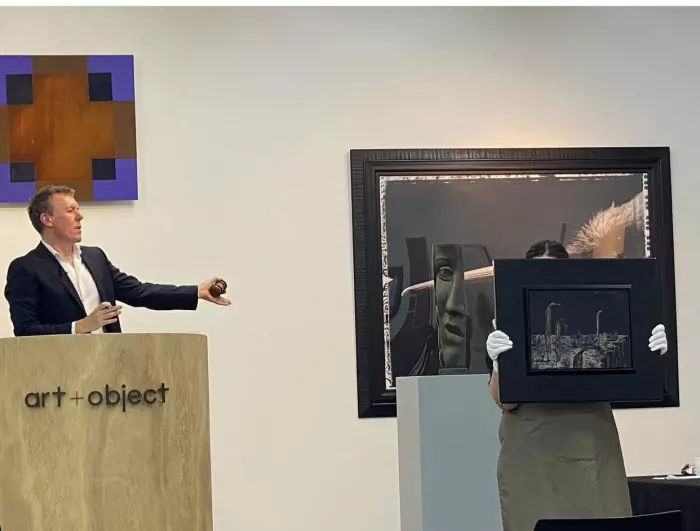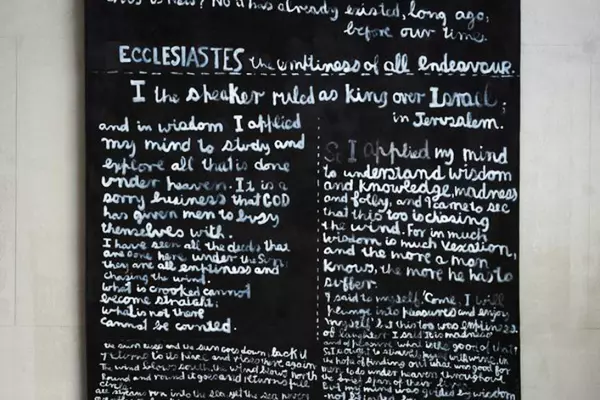Over the next few months, millions of dollars' worth of art is set to be auctioned off in New Zealand.
The offerings will include two corporate collections from Spark and the BNZ, at the International Art Centre and Webb’s respectively, as well as the usual round of mid-winter art sales across all the auction houses.
Auctions are the most public and visible part of the art market, but for the uninitiated they can be a daunting experience. If you’ve been interested in buying at auction and don’t know where to start, here are a few essential tips for a successful purchase.
First, get signed up to the auction house mailing lists. This way you’ll receive all the latest news, auction announcements and links to the online catalogues when they are published.
Hard-copy catalogues are usually posted to clients who have previously bought at an auction. These are normally made public about two weeks before the auction, so once they're available, go through them a number of times – it's very easy to miss works of interest, especially if you are scrolling through pages and pages of artworks.
Some auctions can contain well over 250 items and it’s easy to get viewer fatigue, so looking over the catalogue a few times will make sure you don’t miss anything.
Get informed
If you see something in the catalogue that takes your fancy, that's the time to start doing some preliminary research. Take a look around and get informed.
Have similar works by the artist been sold, and if so, at what price? A quick google search using the artist's name and the title of the work should bring up similar results if they're available, because auction houses publish sales information online after each sale.
Make sure you understand what you're buying, because auction houses work on the "buyer beware" principle. They act as "agent" for the vendor so, as the buyer, it’s your responsibility to satisfy yourself of factors such as the authenticity, medium and condition of the work.
Be sure to find out whether you're buying a print or an original artwork, because this will greatly affect its value.
Prints will be catalogued in various ways, but will have an edition number listed, such as 25/100.
Provided the item is catalogued correctly, you won’t be able to return a purchase if you get the work home and realise you bought a print when you thought you were buying an original.
Go to the viewing
Once the auction is on view, try to get to the viewing. The catalogue illustrations can sometimes be misleading if the colour isn’t reproduced accurately. Works in the catalogue can appear more saturated or washed-out and can look very different when you see them in person.
Take a note of the size and get out a tape measure to check. Often the illustration sizes are standardised to fit on the pages so the dimensions of the works can be hard to gauge.
If you're viewing in person, that's your chance to check the condition of the work. Are there cracks in the canvas or tears in the paper? Does the work appear faded, or loose in the frame? If you aren’t sure about the condition, ask a staff member for their thoughts; remember, though, that they're not painting conservators, so they'll be giving you only their opinion.
If you aren’t able to view in person, ask the auction house for extra photos – of the front and back of the work, and of it in the frame. Ask for a condition report, prepared by the auction house staff, which will highlight any damage that may require conservation.
The auction houses are happy to provide this extra information free of charge, so don’t hesitate to ask for it if you are serious about buying something.
In the days leading up to the auction, decide how you want to take part. You could bid in person in the room, via a telephone or absentee bid, or online.
In the past, absentee bids – those a client leaves with the auction house to make on their behalf – were always confidential, but now they appear on the bidding apps in the days before the sale, so it's easy to gauge pre-auction interest on particular lots.
For example, in a recent sale, a work by Gretchen Albrecht, Night – Nomadic Geometries, was offered with a pre-auction estimate of $75,000 to $95,000. But on the app in the days before the auction, a bid of $95,000 was visible. This was very useful information for anyone interested in that lot, because it told them they would need to bid higher than $95,000 to secure the work.
If you’ve decided to attend the auction in person, be prepared to settle in for the long haul if you are staying until the end.
The increase in online bidding has made auctions a lot longer and, while most auction houses offer refreshments for those in the room, you will be there for a while.
Pick the right seat
Choose your seat carefully, especially if you're bidding. The "trade" (art-world professionals such as dealers and consultants) like to stand at the back to have a chat, to peruse the room and analyse the vibe, and to have a clear sight line to the auctioneer in order to execute their bids.
Most regular clients, however, prefer to sit. Don’t get stuck behind a pillar or group of people if you want to bid, because you may be obscured from the auctioneer. Sitting at the end of a row is preferable and it also allows you a speedy exit if you want to leave partway through the sale.
Once your lot is on offer, make sure you bid efficiently by holding up a paddle or a bidding card, if necessary, to make your interest clear to the auctioneer.
The lights can be bright and the room can go a long way back, which can make it difficult for the auctioneer to see everyone, so discreet hand signals are not helpful unless you're a regular client and the auctioneer knows your bidding style.
And don’t worry, it’s pretty much impossible to accidentally buy an artwork with a cough or by waving to a friend across the room. The auctioneer will always confirm the final bid before selling the lot.
If you're bidding online, make sure you've registered before the auction. Speaking from experience, there's nothing more stressful than trying to fill out all your details and waiting for the approval to come through from the auction house just as bidding on your lot is starting.
There can be a bit of a lag between the room and the auction software, so make sure you’ve decided your maximum bid and execute it swiftly and efficiently.
According to Art + Object managing director Leigh Melville, "online bidding is not the time to play chicken with the auctioneer", so don’t leave your bid until the last second. There is a staff member in the auction room conveying bids from online bidders to the auctioneer so this can cause a lag and you can easily miss out if you are going too slowly.
Consider using a computer rather than a phone to bid; this advice comes from a friend who recently was trying to execute a winning bid when his wife rang on his phone and disrupted the connection, causing him to lose the item.
If you're phone-bidding, try to get into a spot with a good connection. In previous auction-house roles I’ve had, I've executed phone bids for clients who are attending football matches and concerts, and one who was driving through a desert in the Middle East. I couldn’t hear them talking and could only hear myself as an echo – extremely stressful for both me and the client.
If you don’t have good reception, leave a covering bid with the phone-bid staffer – an amount you’d be happy for them to bid up to – in case you get cut off. And if you do get cut off, don’t immediately ring back, as they’ll be trying desperately to reconnect with you.
Add on the premium
Most importantly, remember a buyer’s premium is applied on top of the final hammer price you pay. This can sometimes catch out clients new to auctions.
The buyer’s premium is how the auction houses make their money and the charge can vary between them and the types of auctions, so make sure you read the terms and conditions carefully before purchasing.
Current buyer’s premiums for fine art sales are (correct at 27 June):
- International Art Centre – 17.5% plus GST.
- Art + Object and Dunbar Sloane – 18% plus GST.
- Webb’s – 19.5% plus GST.
That means on a $5000 purchase, the buyer’s premium can take the final purchase price to $6006 at IAC through to $6121.00 at Webb’s. The buyer’s premium can change (always upwards!), so it pays to check the terms and conditions often to make sure you're aware how much your purchase will actually cost.
And a final word of advice from art consultant Sophie Coupland, former head of art at Webb’s and now a regular auction attendee who buys on behalf of clients.
“New buyers often say, 'Oh, I just want to buy what I like,’ and while this is important, what's crucial is working out why you like what you like.
"Obviously, an artwork needs to enrich the space visually and work aesthetically, but what brings greater appreciation is real understanding of the context in which it was made, the political and sociological space it occupies, and where it sits within our cultural and art history.”
So, if you do your research and spend the time getting to know the work, your purchasing experience will be far more meaningful.














